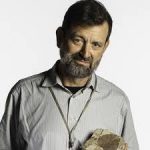By Professor Tiffany Banks On Tuesday, September 30th , students from my COMM 108: Foundations…

The long awaited seminar looking at climate change through the lens of history and the wonderful Deep Time exhibit at the National Museum of Natural History (NMNH) did not disappoint. While we all still wished we had been able to be in the museum, the afternoon presented by Scott Wing, Research Geologist and Curator of Paleobotany, Siobhan Harris, Exhibition Developer and Specialist, and Jen Collins, Office of Education was mesmerizing, and we were quickly immersed in a time long ago.
What is Deep Time? The NMNH website describes it as “The new, 31,000-square-foot fossil hall invites you to explore the epic story of how Earth’s distant past is connected to the present and informs our future. Travel through ancient ecosystems, witness the evolution of life, and get up close to some 700 fossil specimens. Discover how human actions are driving Earth’s rapidly changing climate today much like long-ago geological events did in the past. Learn how to interpret the scientific evidence of the past and present, and see how the choices we make today will live far beyond us, in deep time.”
Scott Wing led off the afternoon, sharing his career journey which began when as a recent high school graduate a summer opportunity to participate in a paleontological field study, turned into a lifelong passion. His presentation, titled “What a long ago episode of global warming says about our future” focused on the Paleocene-Eocene Thermal Maximum period, or PETM which occurred some 56 million years ago. During this time global temperatures increased between 4-8 degrees C, with a warming that lasted for about 200,000 years. An associated period of massive carbon release into the atmosphere has been estimated to have lasted from 20,000 to 50,000 years. This warming resulted in a much wetter, more tropical climate that extended far northward towards the arctic (think palm trees in Alaska!) and provides lessons for what we see happening as a result of the climate changes we are experiencing today. Searching for fossil evidence of these dramatic changes in vegetation became the focus of annual summer expeditions to the Big Bend Basin area of Wyoming. His masterful retelling of the story of his many years of searching and ultimately, finding this evidence, provided a real sense of the long journey of scientific discovery.
Siobhan Harris followed with a fascinating look at what goes into the development of an exhibit in general, and of the Deep Time exhibit in particular, where the overarching goal was to take the stories of Scott and his colleagues and translate them into an exhibit that engages and informs visitors. Given that an estimated 60 million visitors will view this exhibit over the next 30 years, the focus has to be on the present as well as the future. The process included audience surveys in other exhibits where SI staff looked at the kinds of displays most likely to engage visitors. They consulted with social scientists and communication specialists to help develop an understanding of elements of design and communication strategies that could guide their work. What are the elements needed in an exhibit that will work for young children and their grandparents as well as everyone in between? How can objects, videos, art and graphics best express the stories they had to tell? What are the common misperceptions about climate change that need to be explained? This fascinating “behind the exhibit” increased appreciation for Deep Time.
She was followed by Jennifer Collins, Office of Education, who works to develop programs both in the museum and online for families, school groups, teens and adults. In other words, her goal is to develop programs to engage and educate visitors of all ages. She brings her experiences as Manager of Ocean Education and Outreach at NMNH to Deep Time. She talked about some of the specific communication strategies used, the types and placement of interactive opportunities throughout the exhibit and the ways in which volunteers are empowered through in-person training and coaching. She shared a number of resources that have been developed and shared some hints of what is planned when the museum reopens.
While the pandemic prevented us from actually being in the museum today, there is no doubt that this afternoon’s presentation left us all feeling enriched.





This Post Has 0 Comments